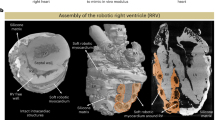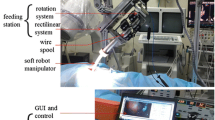Abstract
Efficient coupling of soft robotic cardiac assist devices to the external surface of the heart is crucial to augment cardiac function and represents a hurdle to translation of this technology. In this work, we compare various fixation strategies for local and global coupling of a direct cardiac compression sleeve to the heart. For basal fixation, we find that a sutured Velcro band adheres the strongest to the epicardium. Next, we demonstrate that a mesh-based sleeve coupled to the myocardium improves function in an acute porcine heart failure model. Then, we analyze the biological integration of global interface material candidates (medical mesh and silicone) in a healthy and infarcted murine model and show that a mesh interface yields superior mechanical coupling via pull-off force, histology, and microcomputed tomography. These results can inform the design of a therapeutic approach where a mesh-based soft robotic DCC is implanted, allowed to biologically integrate with the epicardium, and actuated for active assistance at a later timepoint. This strategy may result in more efficient coupling of extracardiac sleeves to heart tissue, and lead to increased augmentation of heart function in end-stage heart failure patients.








Similar content being viewed by others
References
Alferness, C. U.S. Pat. No. 5,702,343. Cardiac reinforcement device. 1996.
Anstadt, M., R. Bartlett, J. Malone, G. Brown, S. Martin, D. Nolan, K. Oberheu, and G. L. Anstadt. Direct mechanical ventricular actuation for cardiac arrest in humans. A clinical feasibility trial. Chest 100:86–92, 1991.
Blom, A. S., R. Mukherjee, J. J. Pilla, A. S. Lowry, W. M. Yarbrough, J. T. Mingoia, J. W. Hendrick, R. E. Stroud, J. E. McLean, J. Affuso, R. C. Gorman, J. H. Gorman, M. A. Acker, and F. G. Spinale. Cardiac support device modifies left ventricular geometry and myocardial structure after myocardial infarction. Circulation 112:1274–1283, 2005.
Chaudhry, P. A., P. V. Anagnostopouls, T. Mishima, G. Suzuki, H. Nair, H. Morita, V. G. Sharov, C. Alferness, and H. N. Sabbah. Acute ventricular reduction with the acorn cardiac support device: effect on progressive left ventricular dysfunction and dilation in dogs with chronic heart failure. J. Card. Surg. 16:118–126, 2001.
Costanzo, M. R., S. Maybaum, A. Bank, I. Anand, B. Rayburn, R. Ivanhoe, and W. Abraham. Ventricular elastic support therapy (VEST) in stage C heart failure-analysis from the PEERLESS-HF study. J. Card. Fail. 16:912, 2010.
Fujimoto, K. L., K. Tobita, W. D. Merryman, J. Guan, N. Momoi, D. B. Stolz, M. S. Sacks, B. B. Keller, and W. R. Wagner. An elastic, biodegradable cardiac patch induces contractile smooth muscle and improves cardiac remodeling and function in subacute myocardial infarction. J. Am. Coll. Cardiol. 49:2292–2300, 2007.
Ghanta, R. K., L. S. Lee, R. Umakanthan, R. G. Laurence, J. A. Fox, R. M. Bolman, L. H. Cohn, and F. Y. Chen. Real-time adjustment of ventricular restraint therapy in heart failure. Eur. J. Cardio-thorac. Surg. 34:1136–1140, 2008.
Horvath, M. A., I. Wamala, E. Rytkin, E. Doyle, C. J. Payne, T. Thalhofer, I. Berra, A. Solovyeva, M. Saeed, S. Hendren, E. T. Roche, P. J. del Nido, C. J. Walsh, and N. V. Vasilyev. An intracardiac soft robotic device for augmentation of blood ejection from the failing right ventricle. Ann. Biomed. Eng. 45:2222–2233, 2017.
Kung, R. T., and M. Rosenberg. Heart booster: a pericardial support device. Ann. Thorac. Surg. 68:764–767, 1999.
Kwon, M. H., M. Cevasco, J. D. Schmitto, and F. Y. Chen. Ventricular restraint therapy for heart failure: a review, summary of state of the art, and future directions. J. Thorac. Cardiovasc. Surg. 144:771–777.e1, 2012.
Lee, L. S., R. K. Ghanta, S. A. Mokashi, O. Coelho-Filho, R. Y. Kwong, M. Kwon, J. Guan, R. Liao, and F. Y. Chen. Optimized ventricular restraint therapy: adjustable restraint is superior to standard restraint in an ovine model of ischemic cardiomyopathy. J. Thorac. Cardiovasc. Surg. 145:824–831, 2013.
Mac Murray, B. C., C. C. Futran, J. Lee, K. W. O‘Brien, A. A. Amiri Moghadam, B. Mosadegh, M. N. Silberstein, J. K. Min, and R. F. Shepherd. Compliant buckled foam actuators and application in patient-specific direct cardiac compression. Soft Robot. 5:99–108, 2018.
Mann, D. L., S. H. Kubo, H. N. Sabbah, R. C. Starling, M. Jessup, J. K. Oh, and M. A. Acker. Beneficial effects of the CorCap cardiac support device: five-year results from the Acorn Trial. J. Thorac. Cardiovasc. Surg. 143:1036–1042, 2012.
Meister, M., and S. M. Wildhirt. Cardiac assistance device and method for the control thereof. Patent: US8944987B2. 2015.
Mokashi, S. A., L. S. Lee, J. D. Schmitto, R. K. Ghanta, S. McGurk, R. G. Laurence, R. M. Bolman, L. H. Cohn, and F. Y. Chen. Restraint to the left ventricle alone is superior to standard restraint. J. Thorac. Cardiovasc. Surg. 146:192–197, 2013.
Moreno, M. R., S. Biswas, L. D. Harrison, G. Pernelle, M. W. Miller, T. W. Fossum, D. A. Nelson, and J. C. Criscione. Development of a non-blood contacting cardiac assist and support device: an in vivo proof of concept study. J. Med. Device 5:41007-1–41007-9, 2011.
Murphy, C. M., M. G. Haugh, and F. J. O’Brien. The effect of mean pore size on cell attachment, proliferation and migration in collagen-glycosaminoglycan scaffolds for bone tissue engineering. Biomaterials 31:461–466, 2010.
Murphy, C. M., and F. J. O’Brien. Understanding the effect of mean pore size on cell activity in collagen-glycosaminoglycan scaffolds. Cell Adhes. Migr. 4:377–381, 2010.
O’Brien, F. J. Biomaterials & scaffolds for tissue engineering. Mater. Today 14:88–95, 2011.
O’Brien, F. J., B. A. Harley, I. V. Yannas, and L. J. Gibson. The effect of pore size on cell adhesion in collagen-GAG scaffolds. Biomaterials 26:433–441, 2005.
O’Neill, C. T., N. S. Phipps, L. Cappello, S. Paganoni, and C. J. Walsh. A soft wearable robot for the shoulder: design, characterization, and preliminary testing, 2017.
Park, J., S. Choi, A. H. Janardhan, S.-Y. Lee, S. Raut, J. Soares, K. Shin, S. Yang, C. Lee, and K.-W. Kang. Electromechanical cardioplasty using a wrapped elasto-conductive epicardial mesh. Sci. Transl. Med. 8:344ra86, 2016.
Payne, C. J., I. Wamala, C. Abah, T. Thalhofer, M. Saeed, D. Bautista-Salinas, M. A. Horvath, N. V. Vasilyev, E. T. Roche, F. A. Pigula, and C. J. Walsh. An implantable extracardiac soft robotic device for the failing heart: mechanical coupling and synchronization. Soft Robot. 2017. https://doi.org/10.1089/soro.2016.0076.
Payne, C. J., I. Wamala, D. Bautista-Salinas, M. Saeed, D. Van Story, T. Thalhofer, M. A. Horvath, C. Abah, J. Pedro, and C. J. Walsh. Soft robotic ventricular assist device with septal bracing for therapy of heart failure. Sci. Robot. 2:6736, 2017.
Polygerinos, P., N. Correll, S. A. Morin, B. Mosadegh, C. D. Onal, K. Petersen, M. Cianchetti, M. T. Tolley, and R. F. Shepherd. Soft robotics: review of fluid-driven intrinsically soft devices; manufacturing, sensing, control, and applications in human–robot interaction. Adv. Eng. Mater. 2017. https://doi.org/10.1002/adem.201700016.
Roche, E. T., M. A. Horvath, A. Alazmani, K. C. Galloway, N. V. Vasilyev, D. J. Mooney, F. A. Pigula, and C. J. Walsh. Design and fabrication of a soft robotic direct cardiac assist device. 2015.
Roche, E. T., M. A. Horvath, I. Wamala, S. E. Song, W. Whyte, Z. Machaidze, N. V. Vasilyev, D. J. Mooney, F. A. Pigula, and C. J. Walsh. Soft robotic sleeve restores heart function. Sci. Transl. Med. 9:3925, 2017.
Sabbah, H. N., V. G. Sharov, P. A. Chaudhry, G. Suzuki, A. Todor, and H. Morita. Chronic therapy with the acorn cardiac support device in dogs with chronic heart failure: three and six months hemodynamic, histologic and ultrastructural findings. J. Heart Lung Transpl. 20:189, 2001.
Sasaki, D., T. Noritsugu, and M. Takaiwa. Development of active support splint driven by pneumatic soft actuator (ASSIST). 2005.
Shahinpoor, M., and K. J. Kim. Design, development and testing of a multi-fingered heart compression/assist device equipped with IPMC artificial muscles. Int. Soc. Opt. Photon. 4329:411–420, 2001.
Smith, E. M. Cardiac massage apparatus. 1962.
Trumble, D. R., C. S. Park, and J. A. Magovern. Copulsation balloon for right ventricular assistance: preliminary trials. Circulation 99:2815–2818, 1999.
Wenk, J. F., L. Ge, Z. Zhang, D. Mojsejenko, D. D. Potter, E. E. Tseng, J. M. Guccione, and M. B. Ratcliffe. Biventricular finite element modeling of the acorn CorCap cardiac support device on a failing heart. Ann. Thorac. Surg. 95:2022–2027, 2018.
Acknowledgments
The authors would like to thank Ronghli Liao Ph.D., Sudeshna Fisch Ph.D., and Souen Ngoy from the Brigham and Women’s Hospital Rodent Cardiovascular Physiology Core for their technical support; the staff at ARCH, Boston Children’s Hospital for help with porcine studies, James Weaver Ph.D. from the Wyss Institute at Harvard University for imaging assistance and Robert Padera M.D. Ph.D. for histological assessment. ETR acknowledges funding from the Massachusetts Institute of Technology (Institute for Medical Engineering Science and the Department of Mechanical Engineering), and the Wyss Institute for Biologically Inspired Engineering at Harvard University. WW and GD acknowledge the Irish Research Council (GOIPG/2017/927) and Science Foundation Ireland (SFI/12/RC/2278).
Author information
Authors and Affiliations
Corresponding author
Additional information
Associate Editor Daniel Elson oversaw the review of this article.
Rights and permissions
About this article
Cite this article
Horvath, M.A., Varela, C.E., Dolan, E.B. et al. Towards Alternative Approaches for Coupling of a Soft Robotic Sleeve to the Heart. Ann Biomed Eng 46, 1534–1547 (2018). https://doi.org/10.1007/s10439-018-2046-2
Received:
Accepted:
Published:
Issue Date:
DOI: https://doi.org/10.1007/s10439-018-2046-2




